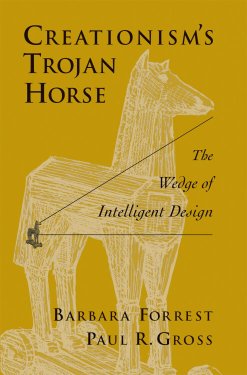
The Drake equation is a probabilistic argument used to estimate the number of active, communicative extraterrestrial civilizations in the Milky Way Galaxy.
Extraterrestrial life, or alien life, is life which does not originate from Earth. No extraterrestrial life has yet been conclusively detected. Such life might range from simple forms such as prokaryotes to intelligent beings, possibly bringing forth civilizations that might be far more advanced than humans. The Drake equation speculates about the existence of sapient life elsewhere in the universe. The science of extraterrestrial life is known as astrobiology.
Intelligent design (ID) is a pseudoscientific argument for the existence of God, presented by its proponents as "an evidence-based scientific theory about life's origins". Proponents claim that "certain features of the universe and of living things are best explained by an intelligent cause, not an undirected process such as natural selection." ID is a form of creationism that lacks empirical support and offers no testable or tenable hypotheses, and is therefore not science. The leading proponents of ID are associated with the Discovery Institute, a Christian, politically conservative think tank based in the United States.
Owen Jay Gingerich was an American astronomer who had been professor emeritus of astronomy and of the history of science at Harvard University and a senior astronomer emeritus at the Smithsonian Astrophysical Observatory. In addition to his research and teaching, he had written many books on the history of astronomy.

In planetary astronomy and astrobiology, the Rare Earth hypothesis argues that the origin of life and the evolution of biological complexity, such as sexually reproducing, multicellular organisms on Earth, and subsequently human intelligence, required an improbable combination of astrophysical and geological events and circumstances. According to the hypothesis, complex extraterrestrial life is an improbable phenomenon and likely to be rare throughout the universe as a whole. The term "Rare Earth" originates from Rare Earth: Why Complex Life Is Uncommon in the Universe (2000), a book by Peter Ward, a geologist and paleontologist, and Donald E. Brownlee, an astronomer and astrobiologist, both faculty members at the University of Washington.

The Center for Science and Culture (CSC), formerly known as the Center for the Renewal of Science and Culture (CRSC), is part of the Discovery Institute (DI), a conservative Christian think tank in the United States. The CSC lobbies for the inclusion of creationism in the form of intelligent design (ID) in public-school science curricula as an explanation for the origins of life and the universe while trying to cast doubt on the theory of evolution. These positions have been rejected by many in the scientific community, which identifies intelligent design as pseudoscientific neo-creationism, whereas the theory of evolution is the accepted scientific consensus.
The intelligent design movement is a neo-creationist religious campaign for broad social, academic and political change to promote and support the pseudoscientific idea of intelligent design (ID), which asserts that "certain features of the universe and of living things are best explained by an intelligent cause, not an undirected process such as natural selection." Its chief activities are a campaign to promote public awareness of this concept, the lobbying of policymakers to include its teaching in high school science classes, and legal action, either to defend such teaching or to remove barriers otherwise preventing it. The movement arose out of the creation science movement in the United States, and is driven by a small group of proponents. The Encyclopædia Britannica explains that ID cannot be empirically tested and that it fails to solve the problem of evil; thus, it is neither sound science nor sound theology.
The Sternberg peer review controversy concerns the conflict arising from the publication of an article supporting intelligent design creationism in a scientific journal, and the subsequent questions of whether proper editorial procedures had been followed and whether it was properly peer reviewed.
Paul A. Nelson is an American philosopher, noted for his advocacy of the pseudosciences of young earth creationism and intelligent design.
Guillermo Gonzalez is a Cuban-born American astronomer who is a proponent of the pseudoscientific principle of intelligent design and a research scientist at the University of Alabama in Huntsville. He is a senior fellow of the Discovery Institute's Center for Science and Culture, considered the hub of the intelligent design movement, and a fellow with the International Society for Complexity, Information and Design, which also promotes intelligent design.
A Scientific Support for Darwinism was a four-day, word-of-mouth petition of scientists in support of evolution. Inspired by Project Steve, it was initiated in 2005 by archaeologist R. Joe Brandon to produce a public response to the Discovery Institute's 2001 petition A Scientific Dissent From Darwinism.
Michael John Denton is a British biochemist who is a proponent of intelligent design and a Senior Fellow at the Discovery Institute's Center for Science and Culture. He holds a PhD degree in biochemistry. Denton's book, Evolution: A Theory in Crisis, inspired intelligent design proponents Phillip Johnson and Michael Behe.

Creationism's Trojan Horse: The Wedge of Intelligent Design is a 2004 book by Barbara Forrest and Paul R. Gross on the origins of intelligent design, specifically the Discovery Institute's Center for the Renewal of Science and Culture and its wedge strategy. The authors are highly critical of what they refer to as intelligent design creationism, and document the intelligent design movement's fundamentalist Christian origins and funding.

Victor John Stenger was an American particle physicist, philosopher, author, and religious skeptic.
The Discovery Institute has conducted a series of related public relations campaigns which seek to promote intelligent design while attempting to discredit evolutionary biology, which the Institute terms "Darwinism". The Discovery Institute promotes the pseudoscientific intelligent design movement and is represented by Creative Response Concepts, a public relations firm.
Jay Wesley Richards is an American analytical philosopher who focuses on the intersection of politics, philosophy, and religion. He is the William E. Simon Senior Research Fellow in Heritage’s DeVos Center for Religion and Civil Society at The Heritage Foundation. He serves as an adjunct professor in the School of Business at the Catholic University of America and the executive editor of The Stream and senior fellow at the Discovery Institute. A former Presbyterian, Richards is now a Catholic.

Expelled: No Intelligence Allowed is a 2008 American documentary-style propaganda film directed by Nathan Frankowski and starring Ben Stein. The film contends that there is a conspiracy in academia to oppress and exclude people who believe in intelligent design. It portrays the scientific theory of evolution as a contributor to communism, fascism, atheism, eugenics, and in particular Nazi atrocities in the Holocaust. Although intelligent design is a pseudoscientific religious idea, the film presents it as science-based, without giving a detailed definition of the concept or attempting to explain it on a scientific level. Other than briefly addressing issues of irreducible complexity, Expelled examines intelligent design purely as a political issue.

The Nexus for Exoplanet System Science (NExSS) initiative is a National Aeronautics and Space Administration (NASA) virtual institute designed to foster interdisciplinary collaboration in the search for life on exoplanets. Led by the Ames Research Center, the NASA Exoplanet Science Institute, and the Goddard Institute for Space Studies, NExSS will help organize the search for life on exoplanets from participating research teams and acquire new knowledge about exoplanets and extrasolar planetary systems.

Rare Earth: Why Complex Life Is Uncommon in the Universe is a 2000 popular science book about xenobiology by Peter Ward, a geologist and evolutionary biologist, and Donald E. Brownlee, a cosmologist and astrobiologist. The book is the origin of the term 'Rare Earth Hypothesis' which denotes the central claim of the book: that complex life is rare in the universe.







